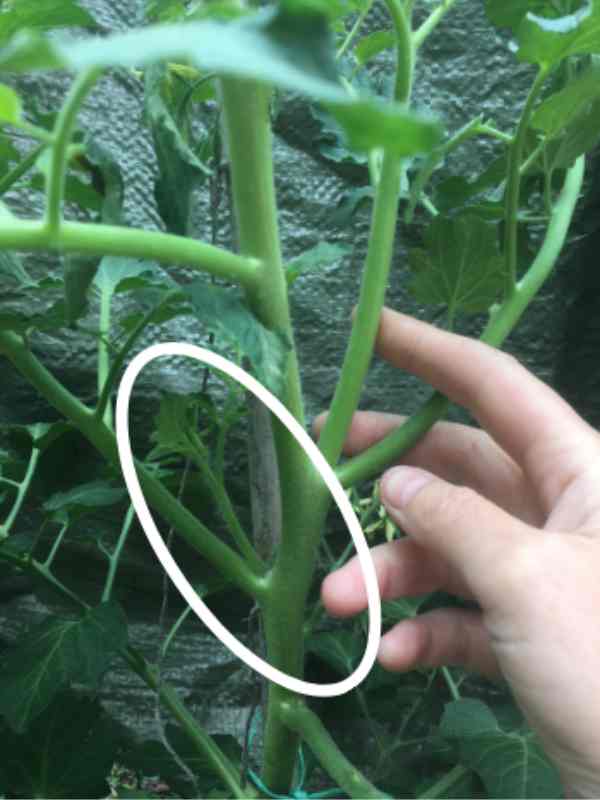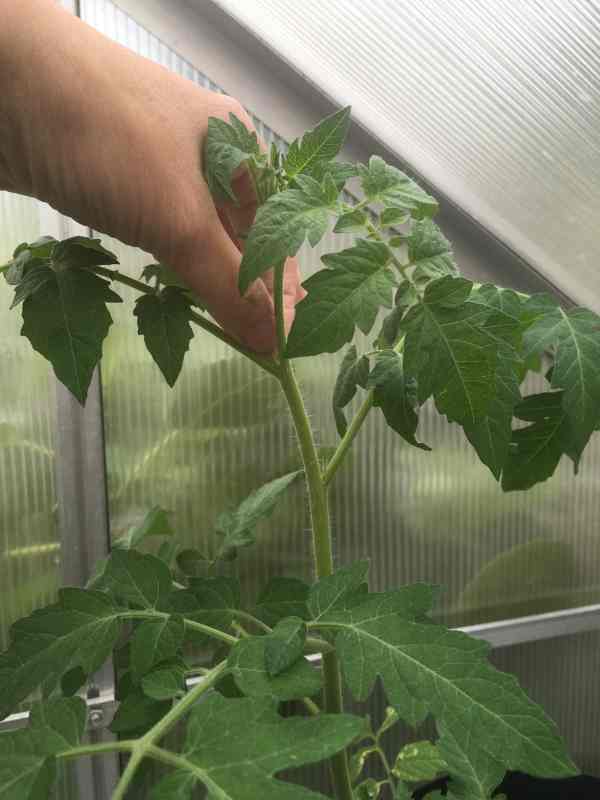This post should help you learn how to remove side shoots on tomatoes and to rope your kids in to help.
If you've found this post, you're probably growing tomatoes and have heard that you're supposed to do something about side shoots or suckers or pruning, but you're not really sure what that means. In this article we will explain:
What are the learning goals?
This post will help children to join in with pruning and for everyone to learn:
What is a side shoot?
Sometimes also spelled as one word "sideshoot" and sometimes called a "sucker" (when they come from near the bottom of the plant), a side shoot is a new shoot which grows out between a main upright stem and a leaf, at a roughly 45 degree angle between the two. If it is left to grow, it will bend upwards and try to form a whole new main stem. Here is a picture of a new side shoot and one which has been allowed to grow on:


Why you should remove side shoots on tomatoes
As you can see, the growth in a side shoot is really strong and within days it can be a really sturdy extra stem, not much thinner than the main stem of the plant, andit already has branching of its own higher up and new, large leaves forming.
If this is left to continue, it will take lots of the energy of the plant to make this new stem. In turn, side shoots will form between this new stem and the leaf joints. And that will make new vigorous stems. All of which uses the plant's energy.
But you might be thinking "Great! Lots more plant means more tomatoes and I don't have to grow as many plants if they all grow bushy like this!" But that's the problem. When tomato plants are allowed to grow like this, they put so much energy into growing, and trying to make flowers on all of the stems that they don't have enough energy left to set and ripen any of the fruit properly. You will end up with a huge bushy plant that topples over under its own weight and has hardly any properly ripened fruit. This is why it is important on most varieties of tomato, to remove side shoots and keep to one main stem.
Whether you should remove them
There is one question you need to answer before you know whether you should remove them, and that is "what type of tomato plant am I growing?"
Cordon Varieties
These are also called "indeterminate" types. If you have one of these then you should remove them. This means that the plant is meant to be grown on one long stem and trained upwards (on a cordon). They have been bred to have vigorous energy in the upwards shoots and so your aim is to concentrate all of that energy into one stem and its fruit. Some types are called "semi-determinate" which are mixtures, but they behave more like an indeterminate and you still need to take side shoots off.
Bush Varieties
These are also called "determinate" types. Then you should NOT remove them. These side shoots are what makes the plant bushy and these varieties have been bred to make smaller, lower plants with lots of small branches that have less vigorous energy and to grow fruit on the new branches too. So leave these ones alone.
You can find out what type you are growing by looking at the seed packet, googling the variety on the label or asking whoever you got the plant from.
When you should remove them
Side shoots start appearing as soon as the plant gets going. you should start removing them as soon as you see them. On most plants this will mean checking from about June onwards and particularly in July and August when the plant is putting on the fastest growth.
Try to catch them when they are little because they are easier to remove (see below). But check your tomato plants at least once a week to see how they are doing.
How to remove them
Removing the side shoots is easy once you know how. The first few times you do it, you will be worrying about whether you have picked the right part to remove and whether you are hurting your plant. This is normal and you will get more confident the more you do it.
If the side shoot is small you can use your first finger and thumb to pinch the shoot off. It is very soft sappy growth and it will easily squish off in your hand without hurting the plant.


If your side shoot is thicker but smaller than a pencil, you will find that just folding it towards you from the base of the shoot will make it snap away easily in your hand.

If the sideshoot is getting towards pencil thickness, then use a small pair of scissors or a little knife to snip them off, as trying to pinch them when they are this fat could make them tear and damage your plant.
Getting kids to help remove side shoots on tomatoes
If you have never done this before, practice yourself before getting children to do it, so you know how it should go.
When you have found some, show them how to pinch it carefully, pinching finger and thumb together so it "clips" off and not pulling or tearing. The plant itself should hardly move. If you hold the stem to stop it wobbling, hold it very gently.
Scissors?
If you have any big side shoots, get some child sized scissors and help them to position the scissors in the correct place, not touching the main stem, so that when they close the scissors they successfully take off the shoot but don't nick the stem. Again tell them to be gentle and still, just closing the scissors, not pulling back towards themselves as they go and tearing.
Repeat this with the whole plant.
Keep checking your plants together over the next weeks and removing the side shoots.
What children can learn from this
While explaining what to do you will need to use and reuse language which describes parts of plants. You can get children to talk to you about other parts too, and point and identify them on the plant. Roots, stems, branches, leaves, flowers, fruit.
Energy
While explaining why removing side shoots is important, you can talk about the plant using energy. Depending on what they know about plants growth, you can talk together about the food, water and light needed to make them grow and how all the processes need energy. You can explain about wanting the energy to be used to make tomatoes rather than lots of leaves.
Proportions
Stopping plants becoming too heavy gives you a chance to talk about weight and height and how things that are tall and have heavy tops can fall over.
Gentleness
Being gentle while removing the shoots gives you an opportunity to talk about why it is easy to crush plants, how the stems are full of liquid, and how they are needed to move food around the plant, so we must be very careful handling stems.
Observation
Over the summer, ask your children to check and identify new shoots as they appear, but if the children are young and might make mistakes, ask them to show you the shoot before they take it off.
Give lots of praise for identifying shoots correctly and for being gentle removing them. Help them to work out when they have identified incorrectly and help them find a correct one.
Here is a useful video from Allotment Book which covers all of the instructions we have covered here:
